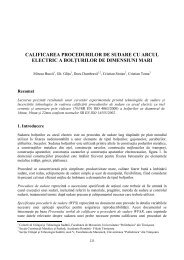cold-formed steel structures: advances in research and design - apcmr
cold-formed steel structures: advances in research and design - apcmr
cold-formed steel structures: advances in research and design - apcmr
- No tags were found...
You also want an ePaper? Increase the reach of your titles
YUMPU automatically turns print PDFs into web optimized ePapers that Google loves.
<strong>in</strong>dividual “element”. Each plate element is treated consider<strong>in</strong>g the stability theory of plates<strong>and</strong> the “effective width” concept for tak<strong>in</strong>g <strong>in</strong>to account both elastic buckl<strong>in</strong>g phenomena<strong>and</strong> post-buckl<strong>in</strong>g effects. As far as the distortional buckl<strong>in</strong>g is concerned, the codifiedprovisions, through the stiffener effectiveness evaluation, extend the methodologies orig<strong>in</strong>allyproposed only for local <strong>in</strong>stability phenomena to the case of distortional buckl<strong>in</strong>g of<strong>in</strong>termediate stiffened <strong>and</strong> edge stiffened elements (“flange distortional” buckl<strong>in</strong>g). Even ifthe current calculation models give comprehensive rules for the determ<strong>in</strong>ation of “effectivesection” <strong>in</strong> the case of different load conditions, they require iterative calculations whichbecome enough complicated for more complex shape of cross section. Moreover, thisapproach ignores the <strong>in</strong>teraction between plate elements <strong>and</strong> does not provide guidance ondistortional phenomena <strong>in</strong>volv<strong>in</strong>g the transverse deformation of flange-to-web <strong>in</strong>tersectionl<strong>in</strong>e (“lateral distortional” buckl<strong>in</strong>g).Significant <strong>advances</strong> <strong>in</strong> technology of manufacture lead to use members made ofhigher strength <strong>steel</strong>s <strong>and</strong> hav<strong>in</strong>g more complex <strong>and</strong> th<strong>in</strong> cross-sections. As <strong>in</strong>evitableconsequence, the <strong>design</strong> procedures must follow this development becom<strong>in</strong>g more <strong>and</strong> morecomplex <strong>and</strong> cumbersome. These difficulties have stimulated the preparation of an ad hocsoftware to help the <strong>design</strong>ers <strong>in</strong> their practical activities. This computer program, named“ColdForm”, represents the ma<strong>in</strong> issue of the book entitled “Design of Metallic Cold-FormedTh<strong>in</strong>-Walled Members” [42].In particular, the ColdForm computer program was created <strong>in</strong> the late 1980s atUniversity of Naples, as a <strong>research</strong> tool for compar<strong>in</strong>g the provisions on th<strong>in</strong>-walled <strong>steel</strong>cross-sections given by CNR 10022 Italian code [43], European code (ECCS-TW7/1 [44])<strong>and</strong> American code (AISI, 1986 [45]). Its first commercial version (ColdForm 2.0) wasdeveloped <strong>in</strong> 1993 with the sponsorship of ACAI (Italian Association of Steel Constructors).It was a Quick Basic version with a W<strong>in</strong>dows-like appearance, which only allowed thecheck<strong>in</strong>g of CFS cross-sections accord<strong>in</strong>g to Eurocode 3 provisions. The present release(ColdForm 3.0 or ColdForm 2001) is a Visual Basic version fully comply<strong>in</strong>g with W<strong>in</strong>dowsst<strong>and</strong>ards, as shown <strong>in</strong> Figure 8. In particular, Figure 8b shows the ColdForm w<strong>in</strong>dow, <strong>in</strong>witch the “Geometrical characteristic” output box appears. Figure 8c presents the evaluatedresistance w<strong>in</strong>dow <strong>in</strong> the case of “Axial compression” together with the relevant “Effectivesections” w<strong>in</strong>dow, while Figure 8d illustrates the check for “Comb<strong>in</strong>ed compression <strong>and</strong>bend<strong>in</strong>g” w<strong>in</strong>dow. F<strong>in</strong>ally, the tabs <strong>in</strong> the “Internal actions” w<strong>in</strong>dow are shown <strong>in</strong> Figure 8e.This version allows the analysis of both <strong>cold</strong>-<strong>formed</strong> <strong>steel</strong> members (accord<strong>in</strong>g toENV 1993-1-3 [39] <strong>and</strong> AISI 1996 [40] provisions) <strong>and</strong> alum<strong>in</strong>ium members (accord<strong>in</strong>g toENV 1999-1-1 [46] provisions).The latest trend is to move towards approaches based on the evaluation of elasticbuckl<strong>in</strong>g “load” through a “whole section” analysis. In fact, different user-friendly numericaltools (CU-FSM [47], THIN-WALL [48]), able to capture the elastic buckl<strong>in</strong>g load of thewhole section through the F<strong>in</strong>ite Strip Method (FSM), are currently available for <strong>design</strong>ers.Accord<strong>in</strong>g to this approach <strong>and</strong> follow<strong>in</strong>g the “direct strength method” [49], the nom<strong>in</strong>alstrength can be “directly” determ<strong>in</strong>ed start<strong>in</strong>g from the values of elastic buckl<strong>in</strong>g load <strong>and</strong>yield load us<strong>in</strong>g appropriate “strength” curves. This procedure has several advantages: (1) thereliability of the method is shown to be comparable to the current specifications[49,50,51,52]; (2) the <strong>in</strong>teractions between the plate elements are taken <strong>in</strong>to account; (3) allthe buckl<strong>in</strong>g phenomena (local, distortional <strong>and</strong> global) are considered; (4) the calculationsare very simple <strong>and</strong> do not require iterations, also <strong>in</strong> the case of sections hav<strong>in</strong>g complexshapes for which the current specifications do not provide provisions; (5) the f<strong>in</strong>ite stripanalyses provide a simple approach also when the CFS members <strong>in</strong>teract with other materialsor constructive components, as <strong>in</strong> the case of purl<strong>in</strong>s stabilised by cladd<strong>in</strong>g or wall studsstabilised by sheath<strong>in</strong>gs [53]. As consequence of these advantages, the <strong>in</strong>clusion of whole
















